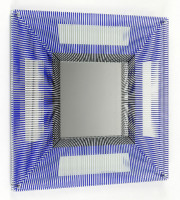
Details
Artist
Styles
Neon sculpture on plexi foot - Hand signed and numbered at the back by the artist. // Linear Sculpture by Geneviève Claisse, created in 1982, is a minimalist neon sculpture that exemplifies Claisse’s exploration of line and form. This work consists of a glowing, geometric neon light in a continuous line, mounted on a black plexiglass base. The sharp, linear form, illuminated in a cool white-blue hue, conveys both simplicity and elegance, embodying Claisse’s commitment to abstraction and geometric precision. The clean, vertical structure draws attention to the beauty of line itself, transforming a basic shape into a radiant, almost ethereal presence. The use of neon adds a modern, industrial touch, bridging the gap between sculpture and light art.
Linear sculpture, 1982
form
Medium
Size
65 x 17 X 17 cm
- Inches
- Centimeters
Edition
Price
- USD
- EUR
- GBP
Details
Artist
Styles
Neon sculpture on plexi foot - Hand signed and numbered at the back by the artist. // Linear Sculpture by Geneviève Claisse, created in 1982, is a minimalist neon sculpture that exemplifies Claisse’s exploration of line and form. This work consists of a glowing, geometric neon light in a continuous line, mounted on a black plexiglass base. The sharp, linear form, illuminated in a cool white-blue hue, conveys both simplicity and elegance, embodying Claisse’s commitment to abstraction and geometric precision. The clean, vertical structure draws attention to the beauty of line itself, transforming a basic shape into a radiant, almost ethereal presence. The use of neon adds a modern, industrial touch, bridging the gap between sculpture and light art.
- Recently Added
- Price (low-high )
- Price (high-low )
- Year (low-high )
- Year (high-low )
What is Hard Edge Art?
Hard Edge art is a style of abstract painting that became popular in the 1960s. It features areas of color separated by crisp, sharp edges that are painted with geometric precision. The term hard-edge painting was coined by art critic Jules Langsner to describe this approach, which contrasts with the softer, more fluid forms of other abstract styles.






















